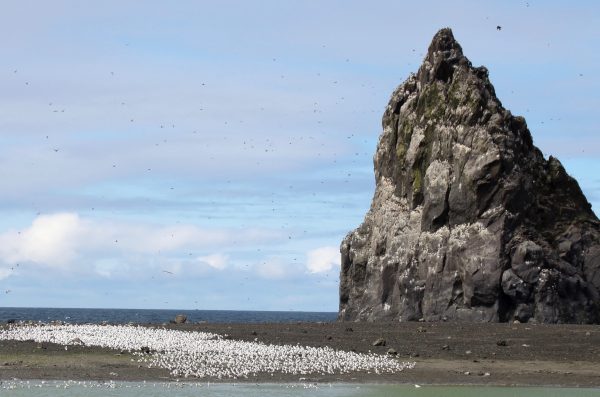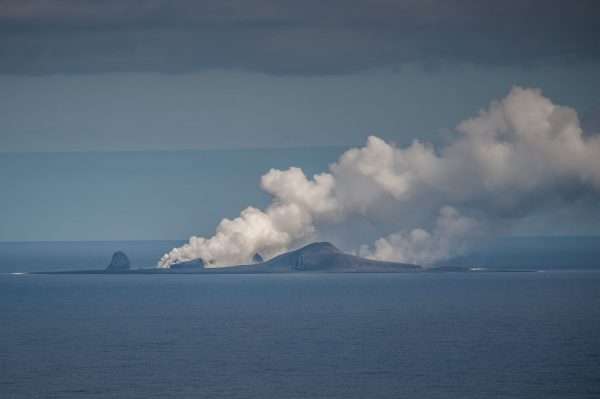Life returns fast to lonely island
February 7, 2019
Ned Rozell
907-474-7468

Bogoslof Island is the gray tip of a mountain that pokes from the choppy surface of the Bering Sea. The volcano stands alone just north of the Aleutians, far south of the larger islands of St. George and St. Paul.
Nora Rojek, a biologist at the Alaska Maritime National Wildlife Refuge based in Homer, once knew Bogoslof well — its screaming seabirds and the roar of waves fizzing at its black sand shores, along with the smell of salt particles suspended in spray.
The Bogoslof that Rojek knew recently reinvented itself, quadrupling in size after its latest eruption, which started about Christmastime 2016 and continued until August 2017. What had been a 74-acre island became a 321-acre island.
On her August 2018 return to Bogoslof, Rojek crinkled her nose at the smell of sulfur. Everyone aboard the refuge ship Tiglax saw steam rising from the gray island. The ashen surface they would be stepping on would be one of the newest landscapes on Earth.
“Everyone was very excited, with a little bit of nervousness,” Rojek said.
Instead of a lifeless pile of charred rock, Rojek and fellow researchers on board saw fur seals hauled out on the beach. Kittiwakes, murres and other birds whirred above, and a pod of killer whales hunted seals just offshore.
“It was definitely back in business,” she said.

Bogoslof has been a protected place since two days before President Teddy Roosevelt left office in 1909. He designated the island as one of the country’s first wildlife refuges.
Each year, the Tiglax sails from Southeast Alaska to the western Arctic coast. But the crew does not get to Bogoslof every year; it’s not on the way to anywhere. Bogoslof visits promise the punishment of stormy open ocean, along with difficult beaches upon which to crash-land an inflatable skiff.
“It’s a really difficult island to get to,” Rojek said. “It’s just sitting out there away from the (Aleutian) chain, with no protection.”
Despite Bogoslof’s self-destructive behavior, animals hung around during the 64 explosive eruptions that reshaped the island between December 2016 and August 2017.
“Even while the eruption was going on, the wildlife used to breeding on Bogoslof came back,” Rojek said. “It’s highly unlikely any of them were successful, but they were coming back.”
Their devotion to the site has something to do with Bogoslof’s location on the shallow waters above the continental shelf, one of the richest places on the planet for sea creatures great and small.
“Bogoslof is just an amazing place for wildlife,” Rojek said. “It’s just jam-packed. There’s something about that spot that’s awesome for all these creatures to feed their young. When you consider how small it is, it’s pretty impressive.”
When Rojek and others walked the island last August, they saw gull chicks that resembled fuzzy tennis balls. The biologists determined the gull parents had built nests out of the only items available, seaweed and driftwood.
Other birds, such as cliff-nesting murres and kittiwakes and the puffins that often dig burrows into cliff edges with fine soil, did not seem as successful. Rojek saw many kittiwakes that seemed to be “loafing,” rather than caring for chicks as they would be on an undisturbed island.
Rojek hopes to be able to go back in summer 2019 to further document what happens after an island hits its own reset button.
“Even though it was very stark, it was very beautiful,” she said. “There were oranges, red and yellows, with different little patterns on the surface. It reminded me of being in Yellowstone.”
Since the late 1970s, the University of Alaska Fairbanks' Geophysical Institute has provided this column free in cooperation with the UAF research community. Ned Rozell is a science writer for the Geophysical Institute.


